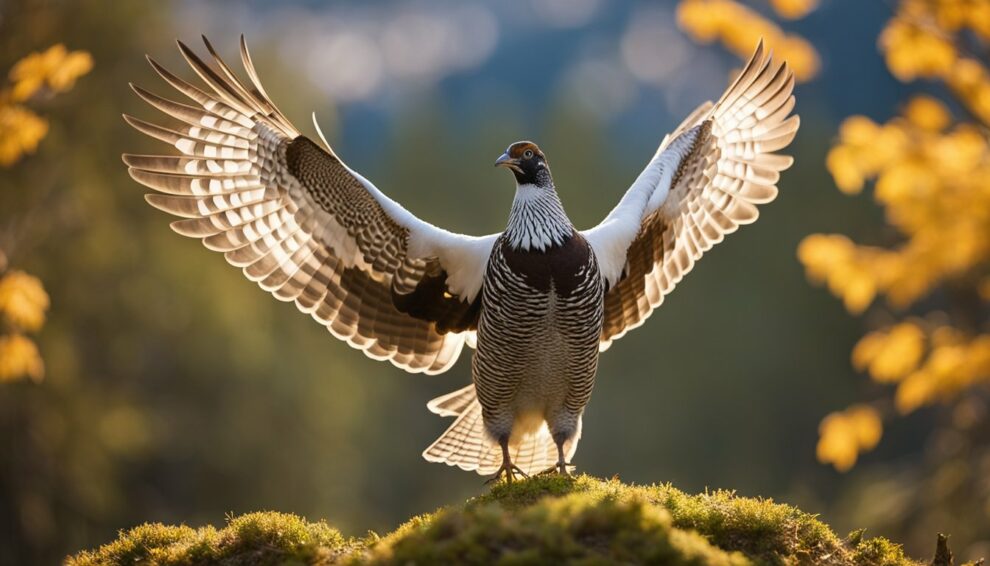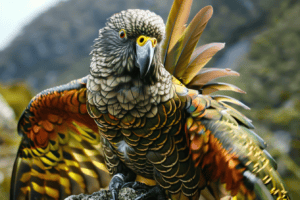As spring unfurls its green fingers across the forests, a unique percussion heralds the onset of a new season.
The ruffed grouse, a plump bird with a flair for theatrics, becomes the woodland’s musician with a beat that resonates through the trees.
This drumming is no ordinary sound; it’s a call of the wild, a courtship ritual designed to charm.
Male grouse find a stage—a fallen log or rock—and they work their wings to create a low, thumping rhythm that’s as surprising to hear as it is to learn it comes from a bird.

Imagine wandering through the woods, when suddenly you hear what seems like an engine struggling to roar to life.
That rolling, deep vibration is a male grouse, saying to the world, and more importantly to prospective mates, “Here I am!” It’s an amazing display of nature’s simplicity and complexity all at once.
The drumming starts slow but speeds up, creating an acoustic wonder that echoes across the forests’ natural auditorium.
Why do these winged performers put on such a show? It’s all part of nature’s grand plan for survival.
Through sounds and sights, grouse communicate, stake their claim, and attract partners.
The spectacle of the drumming grouse is not only a signal to potential mates but also a melody of the season, a sign that everything is waking up from the winter’s sleep.
Watch closely, and you just might catch sight of the elusive ruffed grouse, outfitted with intricate feather patterns and a fan of a tail that’s as much a part of their performance as their rhythmic beats.
The Enigmatic Grouse
Curiosity peeks in the spring air as the forest floor becomes a stage for one of nature’s most intriguing performances.
The ruffed grouse, with their complex behaviors and unique drumming, play a pivotal role in the North American woodlands.
Diverse Habitats and Distribution
The ruffed grouse makes its home across various landscapes, from the deciduous forests of New York to the coniferous woods in Minnesota.
These birds adapt to a wide range of forest habitats, often depending on young forests for survival.
Thriving in environments that wildfires once sculpted, today they rely on sustainable forest management for their habitat needs.
Unique Traits and Behaviors
This bird, often mistaken for a partridge, exhibits a fascinating reproductive strategy.
The male ruffed grouse are polygamous, performing impressive displays to woo females.
They are known for their distinctive drumming display, using a log as their stage to create a rhythmic beat that resonates through the forest, signaling their presence to potential mates.
Threats and Conservation Efforts
Populations of ruffed grouse fluctuate, affected by changes in their habitat and other environmental factors.
Conservation efforts focus on maintaining young forests that are crucial for their nesting and rearing of chicks.
Grouse drumming surveys are critical tools that allow conservationists to track population trends and the health of their ecosystems.
Leks: The Grouse’s Mating Arenas
During the breeding season, male ruffed grouse gather in open areas known as leks, which serve as arenas for their mating displays.
Here, they fan their tail feathers, strut, and drum, each bird fervently advertising his suitability as a mate.
The competitive atmosphere is charged with anticipation, as each male vies for the attention of watching females.
The Science Behind the Drumming
Scientists have studied the drumming of grouse, once a mystery, now revealed to be a vibrational marvel.
The male grouse beats its wings in a crescendo of thumps against the air, creating a sound that can travel through dense forest.
This drumming signals the grouse’s territory and desire for a mate, playing a key role in their life cycle.
Life Cycle of the Ruffed Grouse
The life of a ruffed grouse begins in an egg, carefully tended by the female.
After hatching, the precocious chicks are quick to leave the nest and follow their mother.
The first year is perilous, with many challenges to overcome, but if they survive, they’ll continue the cycle, drumming their way into the next breeding season.
The Rhythmic Drumming Explained

The drumming performance of the grouse is one of nature’s most mesmerizing concerts, filled with complex patterns and meaningful communication.
It’s during the springtime that these birds transform quietude into a stage for courtship, where each beat has a story to tell.
Decoding the Drumming Language
The grouse makes a non-vocal sound by beating its wings against the air to create a series of low-frequency popping sounds, often perceived as ‘drumming’.
This drumming is crucial during the breeding season, as it’s not just a call to potential mates but also a sign of a healthy and formidable male.
It’s this pulsating series of beats that sets the tempo for springtime love in the woods.
An Acoustic Phenomenon
The drumming is an acoustic marvel, reverberating through the dense forests of Minnesota and New York’s North Woods.
The sound is created as the bird’s wings move so rapidly that they briefly lose contact with the air, creating a vacuum and resulting in the characteristic ‘thump’.
Precise weather conditions affect the drumming’s density and audibility, transforming the forest into a natural amphitheater.
Interpreting Drumming Patterns
Each grouse’s drumming display can vary slightly, offering a rich tapestry of rhythm that conveys different messages.
Researchers document these variations using tools such as the Macaulay Library of Natural Sounds.
The drumming patterns are not random—faster beats and more powerful thumps may indicate a more dominant male, and such nuances are key to understanding their life history and reproductive strategies.
Recording Drumming Performances
Capturing these performances requires patience and the right equipment.
Wildlife cinematographers and sound recorders, like Bob McGuire, spend hours in the field, meticulously creating archives that contribute to our understanding of grouse behavior.
These recordings serve as audio censuses that inform conservation efforts and add richness to the narrative content in outlets like BirdNote.
Cultural Significance and Folklore
The mysterious drumming has woven itself into the folklore of many cultures that share their habitat with the grouse.
Stories were told by the likes of Philadelphia naturalist John Bartram, speaking of the grouse’s rhythms as integral to the identity of the land.
The drumming transcends biology and resonates through history and myth.
Journey Through the Seasons with the Grouse
The changing seasons herald shifts in the grouse’s behavior, but the spring drumming display remains a signature.
As winter wanes, males establish ‘leks’, arenas for their competitive displays, reaffirming their presence before the onset of breeding.
After the drumming conquest, the winners will mate, creating nests for the future eggs and chicks.
Getting to Know the Grouse Family
The grouse family encompasses various species, each adapted to their unique habitats.
Despite their diverse living environments—from the lush underbrush to snowy terrains—they share a common thread in their reproductive rhythm.
The life story of a grouse is punctuated by habitat conditions, predation, and the quest for continuity through its offspring.
Frequently Asked Questions

Discover the intricate world of the grouse and their unique drumming performances that herald the arrival of spring.
These displays are not just captivating to observe but also hold a crucial role in their mating rituals.
How do male grouse impress their mates during spring?
During springtime, male grouse take center stage in nature’s amphitheater, impressing their potential mates through a powerful display of drumming.
They rapidly beat their wings in the open air, creating a vacuum that resonates through the forest as a deep, rhythmic sound.
Can you describe how a grouse sounds when it’s performing its drumming courtship?
The sound of a grouse drumming is similar to distant thunder or the starting of an engine, beginning softly and escalating into a rapid series of thumps.
These low-frequency sounds can travel long distances, revealing the presence of a male grouse to females and rival males alike.
What time of year can we observe grouse performing their drumming display?
Grouse perform their drumming display primarily in the spring. This period coincides with the time they are seeking to attract mates.
The forests come alive with their drumming, typically from late March through to early summer, peaking when females are most receptive to mating.
How does drumming help grouse in their mating rituals?
Drumming acts as a dual-purpose signal in grouse mating rituals.
It demonstrates the male’s vigor and health, key traits for attracting a mate, while also serving as a territorial call to ward off competing males.
Females assess the strength and frequency of these calls as cues to select a suitable partner.
In what ways do female grouse respond to the drumming of males?
Female grouse listen attentively to these drumming solos, discerning subtle differences in the male’s performance.
They tend to favor the males who can drum with more power and stamina, as this reflects strong genetics.
The drumming not only captivates their auditory senses but also beckons them closer to the performing male.
What unique behaviors signify the springtime courtship of grouse?
In addition to drumming, the springtime courtship of grouse includes an impressive display of visual cues.
Males may puff up their feathers, fan their tails, and strut around their chosen ‘stage’— a log or rock.
This theatrical combination of sights and sounds creates a courtship ritual that is both mesmerizing and essential for the propagation of their species.









